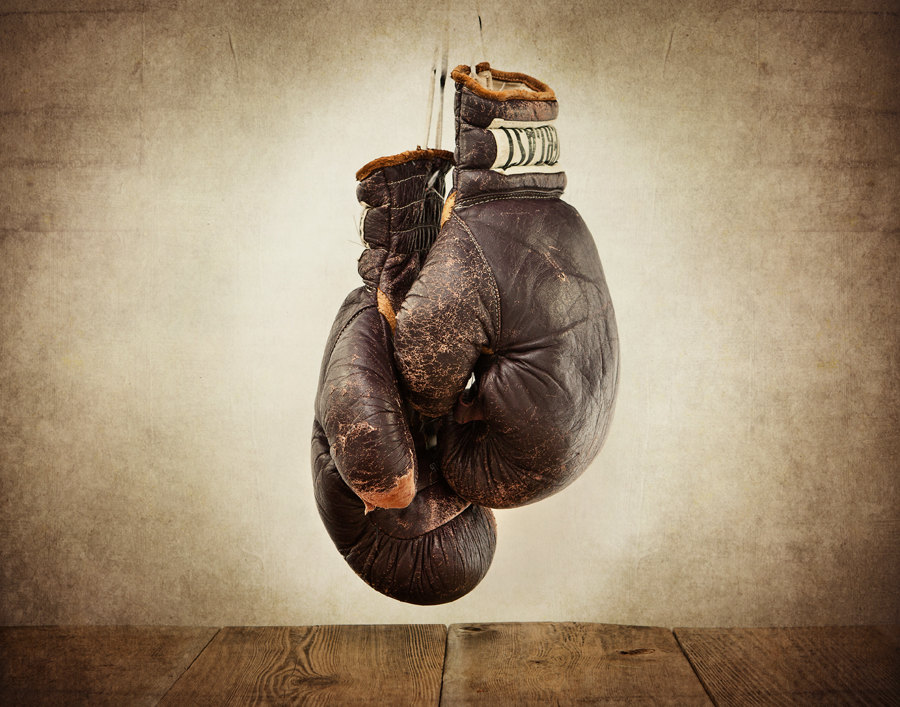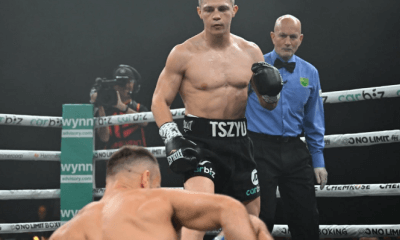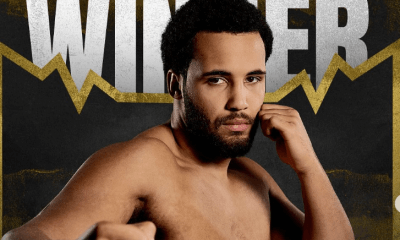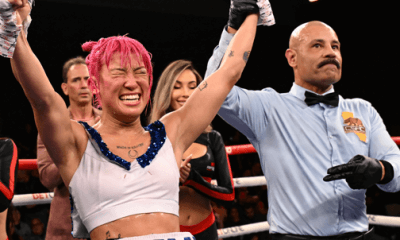Featured Articles
Jeff ‘Candy Slim’ Merritt: A Fighter’s Life (Part Three of a Three Part Series)

Note: When we left Jeff Merritt, he was basking in the glow of his 16th straight victory, having just blasted out Ron Stander on a show in Cleveland promoted by Don King.
After a short rest Merritt was scheduled to face Henry Clark in a rematch of their August 1969 fight. Don King had negotiated a career high purse for Merritt of $10,000 but it would prove a monumental blunder of matchmaking. The Clark fight was scheduled for March 1974. Also scheduled for March 1974 was heavyweight champion George Foreman’s anticipated title defense against Ken Norton. Clark had been acting as Foreman’s chief sparring partner. In Foreman, Clark couldn’t have found better preparation for Merritt. Like Merritt, Foreman was a tall power puncher who often walked in with his hands low, winging punches. Unlike Merritt, Foreman was incredibly strong and much more durable. Clark made much of the fact that he had been a short notice replacement in his first fight with Merritt and that now, in the best shape of his life, he was prepared to get revenge.
Merritt was unfazed by Clark’s tough talk. “He’d have to run up every hill in Oakland and chop down every tree in California and he still won’t beat me.” Merritt likewise had the best preparation for Clark. Clark had always been compared to a poor man’s Muhammad Ali and to prepare for Clark Merritt traveled to Muhammad Ali’s Deer Lake training camp to spar with the genuine article. If Merritt could beat Clark he was expected to have a place of honor on the undercard of Foreman-Norton against either Oscar Bonavena or Jose Luis Garcia but there were hints that he was taking the fight less than seriously.
Larry Holmes, interviewed for this story, stated that Merritt smoked marijuana and began hanging out with the wrong people. In his book he claimed Merritt also drank cough syrup to get high. “I thought the guy could have been champion of the world but he blew it all by hanging out with the wrong people. But you know that’s how it goes. There are a lot of those guys in the sport. He did drugs and I didn’t want any part of that. That’s not Larry Holmes. I figured with what he was in to he was either going to wind up getting shot and killed or die of an overdose.” Earnie Shavers echoed these sentiments. “Jeff was a nice guy but didn’t take care of himself like he should. He was his own worst enemy. Jeff didn’t do right and abused his body.”
In an interview just prior to the Clark fight Don King hinted at these issues as well. “He will be the next heavyweight champion if he keeps his head on straight. He’s his own worst enemy. If he goes astray along the way it will be his own fault.”
The extent that Merritt abused himself prior to Clark is hard to determine. In interviews just prior to the fight he looks healthy, strong, confident, and formidable. Whatever the case, he ran into a buzz saw against Clark. True to his prefight boasting Clark was as prepared for Merritt as he was for any fighter he ever fought. Less than twenty seconds after the bell opened the fight he came over Merritt’s low guard with a left hook that sent Merritt reeling back into his own corner. Clark followed and showered him with punches dropping Candy Slim. Merritt struggled to his feet, dazed and confused, looking awkwardly over his right shoulder at nobody in particular. As Clark moved in Merritt lazily circled but was buzzed with a quick, grazing hook and then sent flying backwards by a pinpoint right hand fired right down the middle and landing squarely on the point of the chin. Merritt landed flat on his back and immediately the contest was waved off. He struggled to his feet and staggered around as he was pointed back to his corner. When he was finally capable of grasping what had happened he looked around in stunned disbelief. For all intents and purposes Merritt’s career was over with this defeat.
In the past six months Merritt had finally cracked the lowest rung of the top ten rankings and in the blink of an eye it was over. It was a stunning blow for Don King as well. Three months earlier his other marquee heavyweight, Earnie Shavers, had similarly been blasted out of contention via a first round knockout courtesy of Jerry Quarry. Undaunted, King was already barreling forward with plans to stage a monumental promotion in the unlikely setting of Zaire between champion George Foreman and Muhammad Ali. While King focused on his “Rumble in the Jungle” he had little time for anything else. As Jeff stewed about the loss to Clark and grew frustrated by King’s lack of attention he fell back into his old habits and one again found himself at odds with the law.
Two weeks before Ali defeated George Foreman in their historic Zaire showdown Merritt was arrested and charged with several crimes. In October Merritt returned to his native Kansas City to visit his family. While riding in a car he was pulled over and taken into custody for questioning. Earlier a group of men had knocked down the door of a home and held a couple at gunpoint while they stole a television, a gun, a watch, and $13. Jeff denied he had been involved but the car he was found in was identified as the getaway vehicle and the gun used in the robbery was found in the car. Merritt, hard to miss at six foot five inches, was picked out of a lineup by the victims.
While in custody Merritt was implicated in the robbery of a craps game that took place on October 16. It was alleged that Merritt had beaten and robbed Otis Myrick and Raymond Medellin of cash and valuables totaling nearly $600. Initially Jeff tried to deny involvement in the armed robbery or that he had taken any money from Myrick or Medellin yet under questioning he admitted his involvement and on the advice of his attorney pleaded guilty to both crimes in the hope of leniency and a shorter sentence. On February 19, 1975 he was sentenced to two terms of five years in the Missouri State Penitentiary to be served concurrently with the seven year sentence he had recently been given for the armed robbery. Jeff Merritt’s life had now come full circle.
Much has been written about Don King’s treatment of Merritt but it’s hard to figure how much more King could have done for Merritt or his career. When he initially took over Merritt’s contract Jeff was a junkie, recently released from jail, and considered such a problem that no other manager wanted anything to do with him. King took Merritt on and turned his career around. In a matter of months he got Merritt his two biggest fights, a top ten ranking, and the best publicity of his career. A manager can only do so much. A fighter has to train and win. Merritt squandered his position by getting knocked out by the light hitting Clark, hanging out with the wrong people, and ultimately winding up back in prison.
When Merritt was paroled just over a year and half after re-entering prison he was ready to get back into the mix. Once again Don King was there. He immediately got Merritt a nationally televised fight on the undercard of George Foreman’s showdown against Scott LeDoux. Merritt would be facing Sacramento prospect Stan Ward. It seemed like King had pitched Merritt a softball. Ward had just five wins to his name and it was hoped that if Merritt could score one of his vintage knockouts he would be matched with Foreman for a career high payday. It was a remarkable opportunity for a fighter who hadn’t fought in two and a half years coming off a devastating one round knockout loss and recently released from prison. There would have been a long line of fighters begging for just such a showcase but King gave the opportunity to Merritt. It’s hard to reconcile that with the idea that King somehow mismanaged Merritt.
As stated above, a manager can only do so much for his fighter. A fighter has to win to keep the paydays coming. Merritt looked to be well on his way to winning in the first round when he shut Ward’s right eye with a series of left hooks and seemed to be having things his own way. But Ward proceeded to hang tough and in the third round clipped Merritt with a right hand that dropped him. After Merritt was dropped again the fight was halted to save Merritt from serious injury. It was Candy Slim’s last chance to carve out a place in boxing history and thereafter he would fade into obscurity.
The following spring Merritt would be picked up on a parole violation. He had slipped back into heroin addiction and was now enrolled in a methadone program. Five months later he was arrested for the attempted murder of Jimmy Ward. Jeff had shot Ward five times outside of a Cleveland nightclub. He was charged with murder, pleaded self-defense and the following June was acquitted. The day after his acquittal he was once again arrested for parole violation and sent back to Missouri to serve his sentence. The next three years were a haze of drugs and multiple prison sentences stemming from parole violations. In 1982 he briefly returned to the ring long enough to knock out Memphis Al Jones. The fight was held in Tulsa, Oklahoma, at a rambling nightclub that specialized in country music. The main event featured Merritt’s old stable-mate Earnie Shavers, like Merritt trying to recapture past glory.
In the late seventies or early eighties Jeff’s mother had moved out to California to be closer to Jeff’s half brother Kenneth. About 1981 she relocated to Las Vegas where most of the family eventually joined her, Jeff included. His family hoped that the move would help Jeff but drugs continued to control his life. He robbed and stole to support his habit. It has been written that Jeff would appear at major boxing events in Las Vegas, homeless and begging for money. This is only part true. Jeff wasn’t homeless, although his addiction may have given him that appearance at times, but he did go to the fights and panhandle often trying to hook up with Don King for a handout. On occasion King would find him and give him some money but usually he was just a sad reminder of the ravages of drug abuse.
Numerous arrests and convictions followed over the years. In 1998 when he was sentenced to prison for the last time he was listed as a habitual criminal. The years of hard living and drug abuse had taken their toll on his once formidable body and while in prison he suffered a stroke that resulted in partial paralysis. He was given early release and spent the remainder of his days confined to a wheel chair, living on disability, and being cared for by his sister Patricia before he passed away June 1, 2014.
Merritt’s legend has only grown over the years, fueled by the early promise he exhibited and the occasional tantalizing mention he gets in passing by men like Muhammad Ali, Earnie Shavers, and Larry Holmes. Jack Newfield was largely responsible for writing the modern narrative of Jeff Merritt’s career in his expose of Don King, painting Merritt as the victim of King’s malevolence. Despite Merritt’s relatively meager accomplishments inside the ring he has become one of boxing’s greatest what-if stories. According to Shavers, Merritt “could have been champion for a thousand years if he had taken care of himself.” But Jeff didn’t take care of himself and rather than a what-if story he serves as a cautionary tale for young fighters. Jeff used his ability in the ring to create multiple opportunities for himself and invariably he squandered them each time, choosing instead to live in the moment and not for the future. A quick fix was more attractive than three months of training. A night on the town was easier than thirty minutes in the ring. His contemporaries Earnie Shavers and Larry Holmes have both settled into a comfortable life in their declining years while Merritt, who chose a less Spartan path, had a considerably more difficult life after boxing. In the end the man who may have had more potential than both of them remains a fascinating footnote for fans of boxing to ponder.
Check out more boxing news on video at The Boxing Channel
-

 Featured Articles4 weeks ago
Featured Articles4 weeks agoThe Hauser Report: Zayas-Garcia, Pacquiao, Usyk, and the NYSAC
-

 Featured Articles3 weeks ago
Featured Articles3 weeks agoOscar Duarte and Regis Prograis Prevail on an Action-Packed Fight Card in Chicago
-

 Featured Articles2 weeks ago
Featured Articles2 weeks agoThe Hauser Report: Cinematic and Literary Notes
-

 Book Review2 weeks ago
Book Review2 weeks agoMark Kriegel’s New Book About Mike Tyson is a Must-Read
-

 Featured Articles4 weeks ago
Featured Articles4 weeks agoRemembering Dwight Muhammad Qawi (1953-2025) and his Triumphant Return to Prison
-

 Featured Articles6 days ago
Featured Articles6 days agoMoses Itauma Continues his Rapid Rise; Steamrolls Dillian Whyte in Riyadh
-

 Featured Articles3 weeks ago
Featured Articles3 weeks agoRahaman Ali (1943-2025)
-

 Featured Articles2 weeks ago
Featured Articles2 weeks agoTop Rank Boxing is in Limbo, but that Hasn’t Benched Robert Garcia’s Up-and-Comers


















